2009 PONTIAC G8 ECU
[x] Cancel search: ECUPage 5 of 356
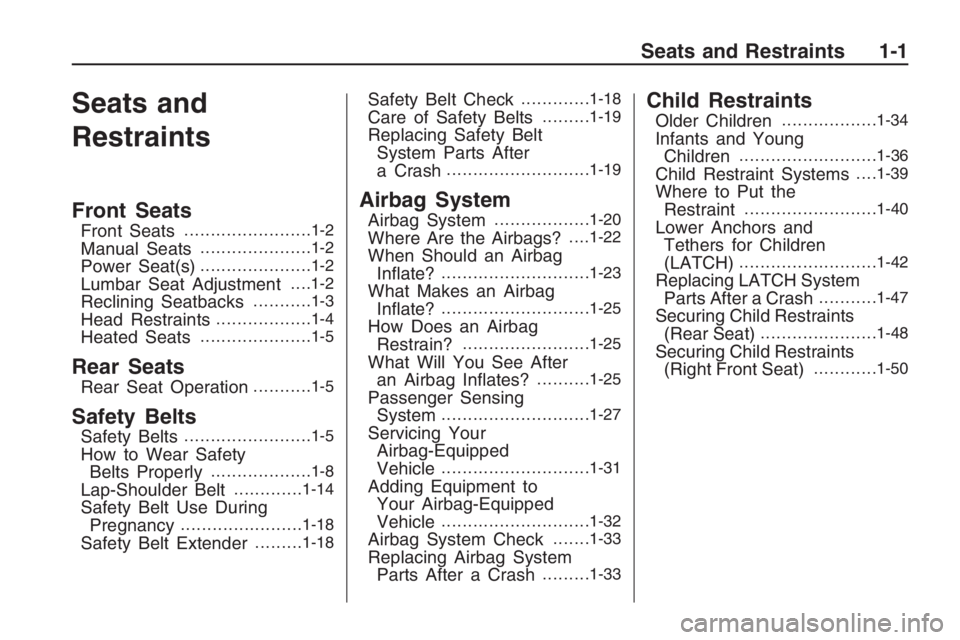
Seats and
Restraints
Front Seats
Front Seats........................1-2
Manual Seats.....................1-2
Power Seat(s).....................1-2
Lumbar Seat Adjustment. . . .1-2
Reclining Seatbacks...........1-3
Head Restraints..................1-4
Heated Seats.....................1-5
Rear Seats
Rear Seat Operation...........1-5
Safety Belts
Safety Belts........................1-5
How to Wear Safety
Belts Properly...................1-8
Lap-Shoulder Belt.............1-14
Safety Belt Use During
Pregnancy.......................1-18
Safety Belt Extender.........1-18
Safety Belt Check.............1-18
Care of Safety Belts.........1-19
Replacing Safety Belt
System Parts After
a Crash
...........................1-19
Airbag System
Airbag System..................1-20
Where Are the Airbags?. . . .1-22
When Should an Airbag
In�ate?............................1-23
What Makes an Airbag
In�ate?............................1-25
How Does an Airbag
Restrain?........................1-25
What Will You See After
an Airbag In�ates?..........1-25
Passenger Sensing
System............................1-27
Servicing Your
Airbag-Equipped
Vehicle
............................1-31
Adding Equipment to
Your Airbag-Equipped
Vehicle
............................1-32
Airbag System Check.......1-33
Replacing Airbag System
Parts After a Crash.........1-33
Child Restraints
Older Children..................1-34
Infants and Young
Children..........................1-36
Child Restraint Systems. . . .1-39
Where to Put the
Restraint.........................1-40
Lower Anchors and
Tethers for Children
(LATCH)
..........................1-42
Replacing LATCH System
Parts After a Crash...........1-47
Securing Child Restraints
(Rear Seat)......................1-48
Securing Child Restraints
(Right Front Seat)............1-50
Seats and Restraints 1-1
Page 18 of 356
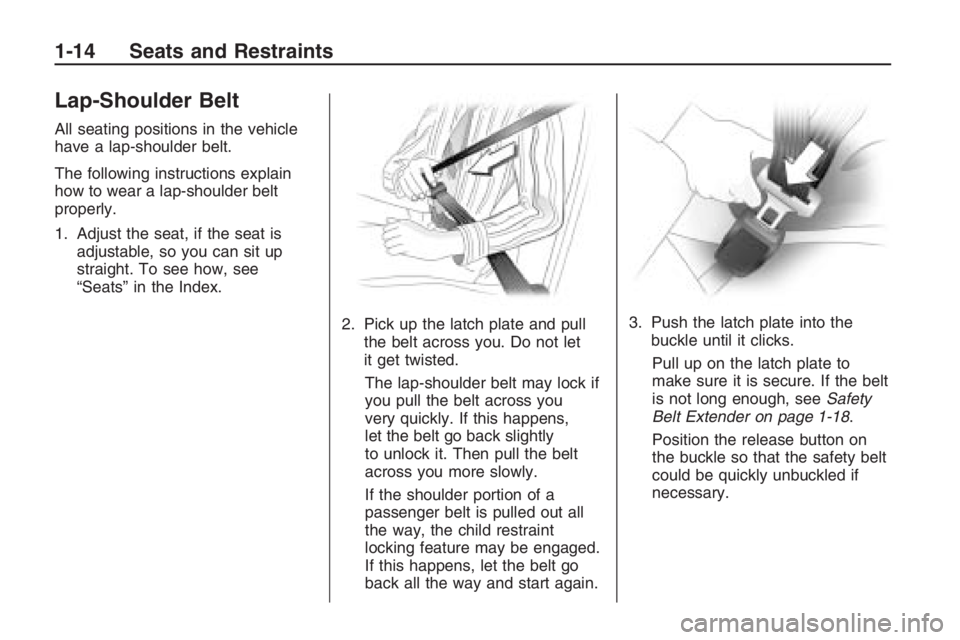
Lap-Shoulder Belt
All seating positions in the vehicle
have a lap-shoulder belt.
The following instructions explain
how to wear a lap-shoulder belt
properly.
1. Adjust the seat, if the seat is
adjustable, so you can sit up
straight. To see how, see
“Seats” in the Index.
2. Pick up the latch plate and pull
the belt across you. Do not let
it get twisted.
The lap-shoulder belt may lock if
you pull the belt across you
very quickly. If this happens,
let the belt go back slightly
to unlock it. Then pull the belt
across you more slowly.
If the shoulder portion of a
passenger belt is pulled out all
the way, the child restraint
locking feature may be engaged.
If this happens, let the belt go
back all the way and start again.3. Push the latch plate into the
buckle until it clicks.
Pull up on the latch plate to
make sure it is secure. If the belt
is not long enough, seeSafety
Belt Extender on page 1-18.
Position the release button on
the buckle so that the safety belt
could be quickly unbuckled if
necessary.
1-14 Seats and Restraints
Page 21 of 356
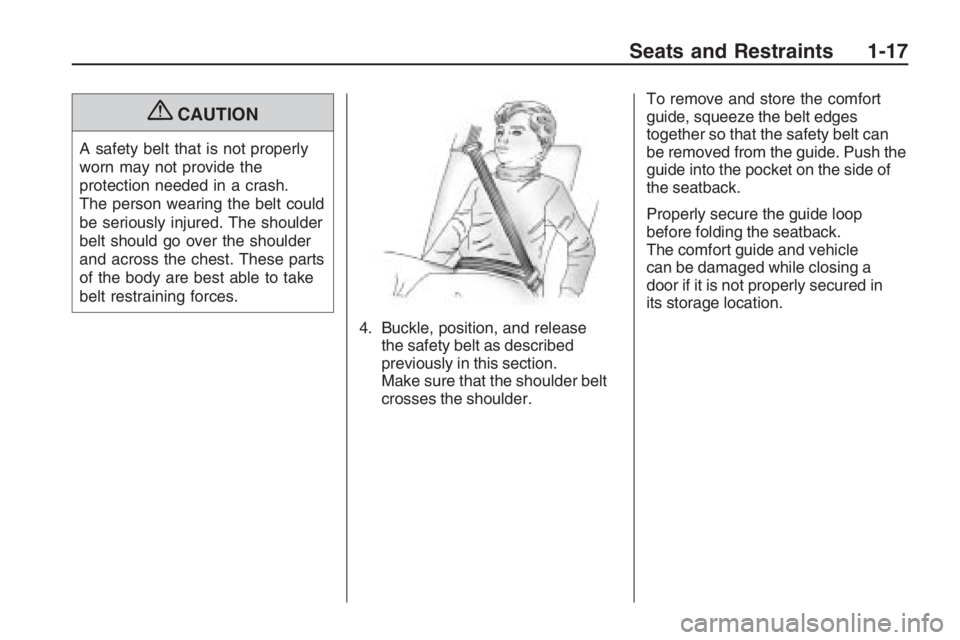
{CAUTION
A safety belt that is not properly
worn may not provide the
protection needed in a crash.
The person wearing the belt could
be seriously injured. The shoulder
belt should go over the shoulder
and across the chest. These parts
of the body are best able to take
belt restraining forces.
4. Buckle, position, and release
the safety belt as described
previously in this section.
Make sure that the shoulder belt
crosses the shoulder.To remove and store the comfort
guide, squeeze the belt edges
together so that the safety belt can
be removed from the guide. Push the
guide into the pocket on the side of
the seatback.
Properly secure the guide loop
before folding the seatback.
The comfort guide and vehicle
can be damaged while closing a
door if it is not properly secured in
its storage location.
Seats and Restraints 1-17
Page 22 of 356

Safety Belt Use During
Pregnancy
Safety belts work for everyone,
including pregnant women. Like all
occupants, they are more likely
to be seriously injured if they do not
wear safety belts.
A pregnant woman should wear a
lap-shoulder belt, and the lap portion
should be worn as low as possible,
below the rounding, throughout
the pregnancy.The best way to protect the fetus is
to protect the mother. When a safety
belt is worn properly, it is more likely
that the fetus will not be hurt in a
crash. For pregnant women, as for
anyone, the key to making safety
belts effective is wearing them
properly.
Safety Belt Extender
If the safety belt will fasten around
you, you should use it.
But if a safety belt is not long
enough, your dealer/retailer will order
you an extender. When you go in to
order it, take the heaviest coat you
will wear, so the extender will be long
enough for you. To help avoid
personal injury, do not let someone
else use it, and use it only for the
seat it is made to �t. The extender
has been designed for adults.
Never use it for securing child seats.
To wear it, attach it to the regular
safety belt. For more information,
see the instruction sheet that comes
with the extender.
Safety Belt Check
Now and then, check the safety belt
reminder light, safety belts, buckles,
latch plates, retractors and
anchorages are working properly.
Look for any other loose or damaged
safety belt system parts that might
keep a safety belt system from doing
its job. See your dealer/retailer to
have it repaired. Torn or frayed
safety belts may not protect you in a
crash. They can rip apart under
impact forces. If a belt is torn or
frayed, get a new one right away.
Make sure the safety belt reminder
light is working. SeeSafety Belt
Reminders on page 4-12for more
information.
Keep safety belts clean and dry.
SeeCare of Safety Belts on
page 1-19.
1-18 Seats and Restraints
Page 25 of 356
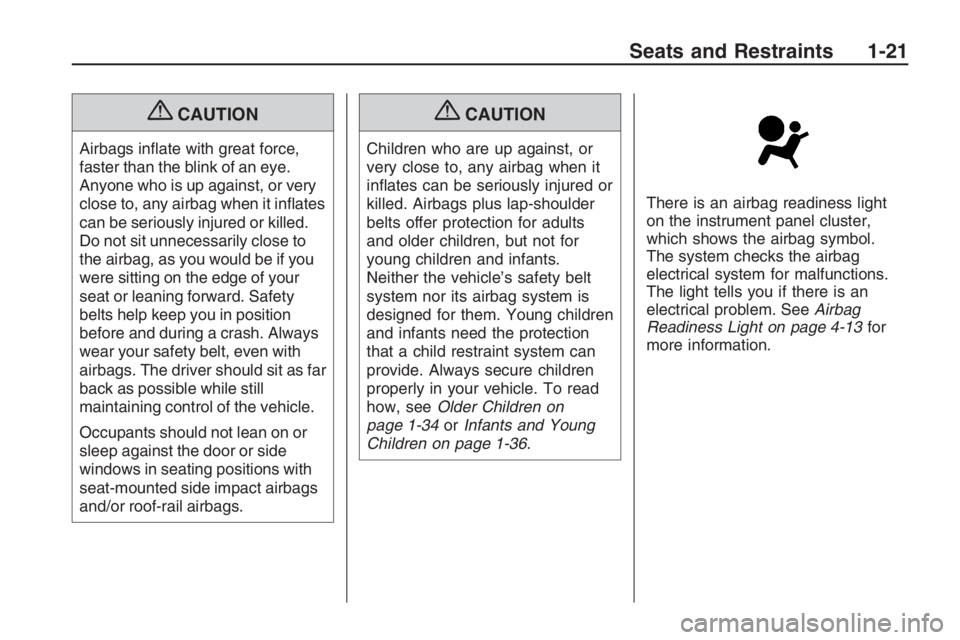
{CAUTION
Airbags in�ate with great force,
faster than the blink of an eye.
Anyone who is up against, or very
close to, any airbag when it in�ates
can be seriously injured or killed.
Do not sit unnecessarily close to
the airbag, as you would be if you
were sitting on the edge of your
seat or leaning forward. Safety
belts help keep you in position
before and during a crash. Always
wear your safety belt, even with
airbags. The driver should sit as far
back as possible while still
maintaining control of the vehicle.
Occupants should not lean on or
sleep against the door or side
windows in seating positions with
seat-mounted side impact airbags
and/or roof-rail airbags.
{CAUTION
Children who are up against, or
very close to, any airbag when it
in�ates can be seriously injured or
killed. Airbags plus lap-shoulder
belts offer protection for adults
and older children, but not for
young children and infants.
Neither the vehicle’s safety belt
system nor its airbag system is
designed for them. Young children
and infants need the protection
that a child restraint system can
provide. Always secure children
properly in your vehicle. To read
how, seeOlder Children on
page 1-34orInfants and Young
Children on page 1-36.There is an airbag readiness light
on the instrument panel cluster,
which shows the airbag symbol.
The system checks the airbag
electrical system for malfunctions.
The light tells you if there is an
electrical problem. SeeAirbag
Readiness Light on page 4-13for
more information.
Seats and Restraints 1-21
Page 26 of 356
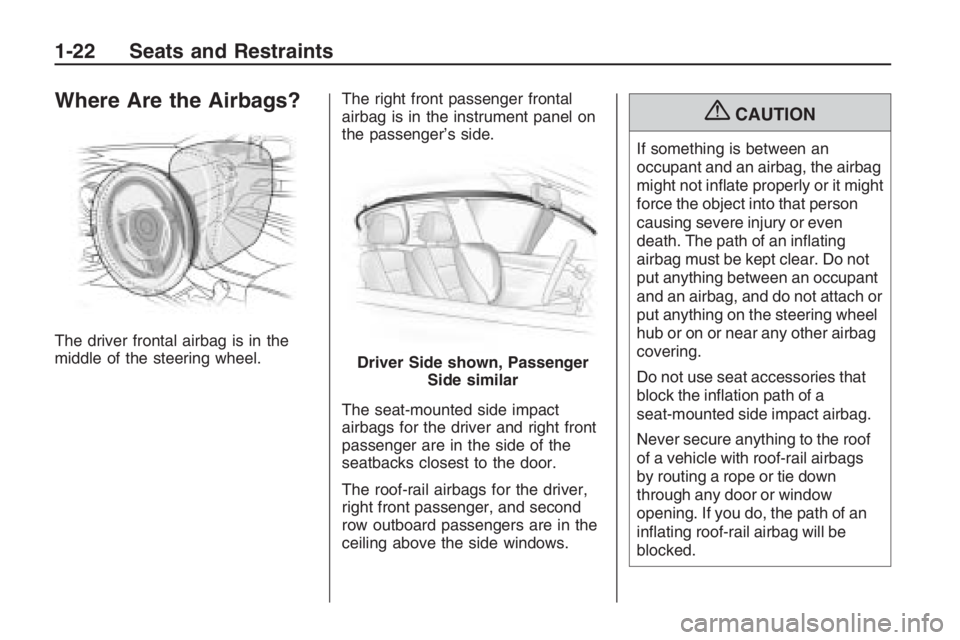
Where Are the Airbags?
The driver frontal airbag is in the
middle of the steering wheel.The right front passenger frontal
airbag is in the instrument panel on
the passenger’s side.
The seat-mounted side impact
airbags for the driver and right front
passenger are in the side of the
seatbacks closest to the door.
The roof-rail airbags for the driver,
right front passenger, and second
row outboard passengers are in the
ceiling above the side windows.
{CAUTION
If something is between an
occupant and an airbag, the airbag
might not in�ate properly or it might
force the object into that person
causing severe injury or even
death. The path of an in�ating
airbag must be kept clear. Do not
put anything between an occupant
and an airbag, and do not attach or
put anything on the steering wheel
hub or on or near any other airbag
covering.
Do not use seat accessories that
block the in�ation path of a
seat-mounted side impact airbag.
Never secure anything to the roof
of a vehicle with roof-rail airbags
by routing a rope or tie down
through any door or window
opening. If you do, the path of an
in�ating roof-rail airbag will be
blocked.
Driver Side shown, Passenger
Side similar
1-22 Seats and Restraints
Page 31 of 356

Passenger Sensing
System
The vehicle has a passenger
sensing system for the right front
passenger position. The passenger
airbag status indicator will be
visible in the rearview mirror when
the vehicle is started.The words ON and OFF, or the
symbol for on and off, will be visible
during the system check. If you
are using remote start to start the
vehicle from a distance, if equipped,
you may not see the system
check. When the system check is
complete, either the word ON
or OFF, or the symbol for on or off,
will be visible. SeePassenger
Airbag Status Indicator on
page 4-14.
The passenger sensing system will
turn off the right front passenger
frontal airbag under certain
conditions. The driver airbags are
not affected by the passenger
sensing system.The passenger sensing system
works with sensors that are part of
the right front passenger seat. The
sensors are designed to detect the
presence of a properly-seated
occupant and determine if the right
front passenger frontal airbag should
be enabled (may in�ate) or not.
Accident statistics show that children
are safer if they are restrained in
the rear rather than the front seat.
We recommend that children
be secured in a rear seat, including:
an infant or a child riding in a
rear-facing child restraint; a child
riding in a forward-facing child seat;
an older child riding in a booster
seat; and children, who are
large enough, using safety belts. United States
Canada
Seats and Restraints 1-27
Page 32 of 356
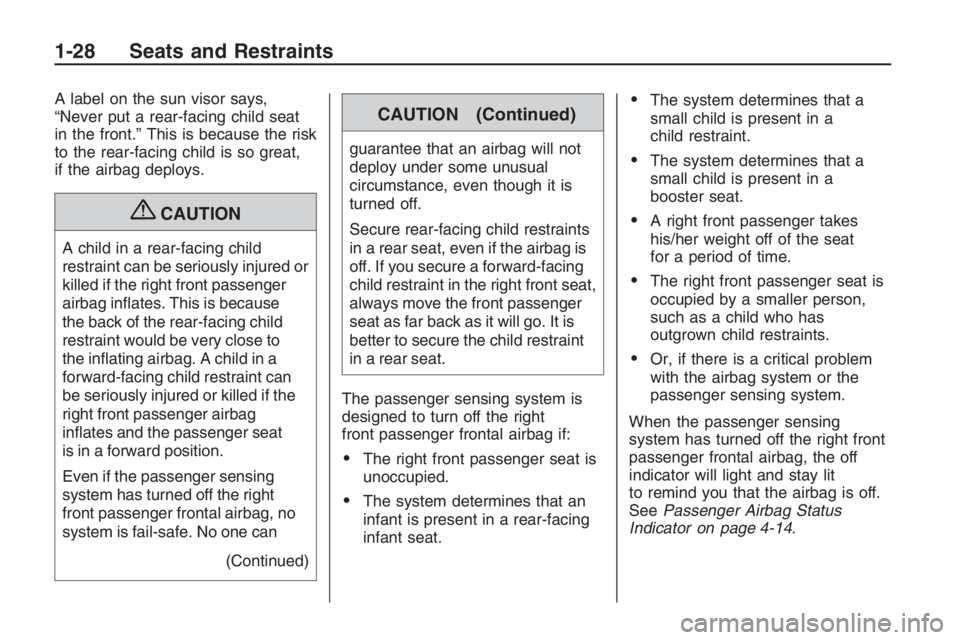
A label on the sun visor says,
“Never put a rear-facing child seat
in the front.” This is because the risk
to the rear-facing child is so great,
if the airbag deploys.
{CAUTION
A child in a rear-facing child
restraint can be seriously injured or
killed if the right front passenger
airbag in�ates. This is because
the back of the rear-facing child
restraint would be very close to
the in�ating airbag. A child in a
forward-facing child restraint can
be seriously injured or killed if the
right front passenger airbag
in�ates and the passenger seat
is in a forward position.
Even if the passenger sensing
system has turned off the right
front passenger frontal airbag, no
system is fail-safe. No one can
(Continued)
CAUTION (Continued)
guarantee that an airbag will not
deploy under some unusual
circumstance, even though it is
turned off.
Secure rear-facing child restraints
in a rear seat, even if the airbag is
off. If you secure a forward-facing
child restraint in the right front seat,
always move the front passenger
seat as far back as it will go. It is
better to secure the child restraint
in a rear seat.
The passenger sensing system is
designed to turn off the right
front passenger frontal airbag if:
The right front passenger seat is
unoccupied.
The system determines that an
infant is present in a rear-facing
infant seat.
The system determines that a
small child is present in a
child restraint.
The system determines that a
small child is present in a
booster seat.
A right front passenger takes
his/her weight off of the seat
for a period of time.
The right front passenger seat is
occupied by a smaller person,
such as a child who has
outgrown child restraints.
Or, if there is a critical problem
with the airbag system or the
passenger sensing system.
When the passenger sensing
system has turned off the right front
passenger frontal airbag, the off
indicator will light and stay lit
to remind you that the airbag is off.
SeePassenger Airbag Status
Indicator on page 4-14.
1-28 Seats and Restraints